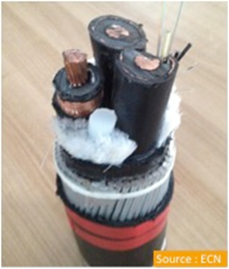
Background
Dynamic umbilical power cables connect a floating energy converter to a buried submarine cable that will connect the offshore production systems to the onshore power grid. These umbilical cables are subjected to severe and repeated mechanical loads throughout their life in operation, and they represent one of the supposed weak points of the global chain of electrical production. It is therefore necessary to develop techniques to diagnose continuously and in situ the state of these cables to anticipate possible premature aging and adapt the maintenance to the estimated residual life of the cable.
Elastic guided waves are of great interest for the non destructive evaluation (NDE) of cables. These waves are likely to propagate over long distances and to be sensitive to small size damages. Because of the multimodal and dispersive nature of guided waves, accurate and high frequency modeling tools are necessary to understand and optimize propagation, and hereby, for the design of NDE techniques and the assessment of their feasibility in operational conditions. As far as MRE cables are concerned, propagation models must be developed including several complicating effects : highly heterogeneous cross-section (multi-wire), mechanical contact between components, helical geometry, prestress,…
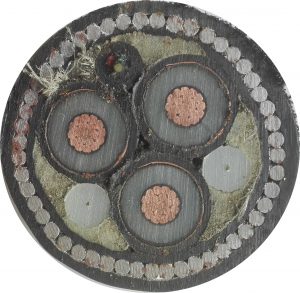
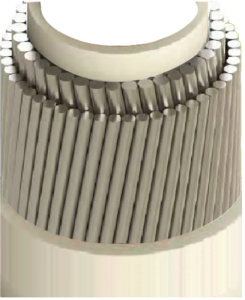
Fig 1 : Left : cross-section of a simple armor cable – Right : structure of a double armor
Scientific advances and innovation
- Development of numerical modeling and solution methods for elastic guided wave propagation in MRE cables.
- Experimental validation of numerical models.
- Instrumentation design for assessing the feasibility of elastic guided waves for the NDE of cables (in particular for the armors of umbilical cables).
Expected technical and economic impact
- Advances in the knowledge and physical understanding of wave phenomena in MRE cables.
- Potential application : development of structural health monitoring, reliable and low cost on-site techniques for the non destructive evaluation and the structural health monitoring of cables
Key project milestones
- November 2016 - Project kick-off
- Feb. 2017 - Beginning of numerical modeling of simple armor cables
- Oct. 2017 - Beginning of numerical modeling of double armor cables
- June 2018 - Starting experimental validation
- November 2019 - End of the project
Results
The approach developed in the project for the modeling of a simple armor (static cable) combines two methods. On the one hand, we use a specific two-dimensional numerical method, which preserves the analytical description of the problem in a third direction, corresponding to the helical direction of propagation. This method enables to take into account the continuous helical symmetry of the armor and its surrounding coatings. On the other hand, we use the theory of periodic media to take into account the discrete rotational symmetry of the cross-section. Accounting for these two types of symmetry in the models makes it possible to reduce considerably the size of the problems to be solved without any approximation (reduction of a factor greater than 1000 compared to a full 3D model). As an indication, we can reduce the number of degrees of freedom (size of matrices involved in numerical resolutions) from the order of two billion in 3D (Figure 2 on the left), to one million in 2D (Figure 2 on the right), then finally to only 20,000 by rotationnal symmetry (Figure 3 on the left). This provides numerical solutions for high frequency waves, as required for non-destructive evaluation techniques based on guided waves. The models account for the effects of the contact between wires and coatings and the viscoelastic losses in the materials.
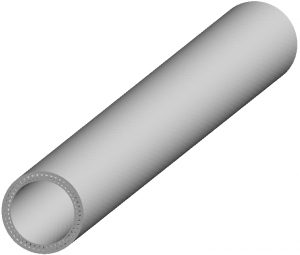
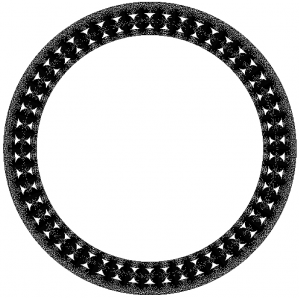
Figure 2 : 3D model of a simple armor (left) ans its 2D cross-section (right)
The simple armor model can compute the mechanical fields related to static loadings (external pressure, elongation, …) as well as the dispersion curves of the wave modes (wave velocity, attenuation, …) – see Figure 3. The model has been validated both numerically and experimentally. The simulations can be used to estimate the propagation distances of the waves, which is crucial to evaluate the feasibility of guided wave-based NDE techniques.
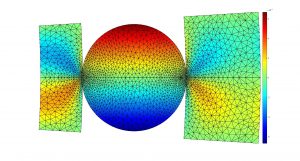
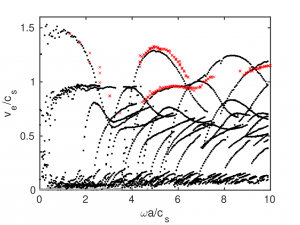
Figure 3 : numerical results for a simple armor. Left : mesh of the unit cell of the problem and static microscopic axial displacement, right : normalized energy velocity of wave modes as a function of frequency. Red crosses : experimental results.
Experimental results obtained on a sample with a broken wire defect confirm the trends in the simulations, namely that the most attractive modes for the END are rather in a low frequency regime (see Figure 4). Two modes of potential interest for the NDE of the armor wires have been identified: the L(0,3) mode around 1.3MHz, with an attenuation of about 30dB (propagation distance of 2-3m), and the L(0,1) mode, which is the least attenuated mode, with an attenuation of the order of 15dB around 400kHz (propagation distance of about 5m). The L(0.2) mode exhibits an attenuation comparable to the L(0.3) mode but is less excitable, and the higher order modes L(0, n) (n>3) are significantly more attenuated than the others.
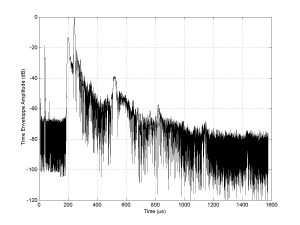
Figure 4 : time signals measured experimentally in transmission in a wire of the umbilical cable (broadband excitation). The different peaks correspond to the echoes generated by the ends of the sample. A time-frequency analysis enables to identify that the most echogenic modes are the low frequency modes.
A magnetostrictive device has been experimented. This device has the advantage of being contactless (encircling locally). It operates in a low frequency regime, more compatible with the propagation of the L(0,1) mode, which leads to propagation distance up to 9m in a low-frequency regime. Moreover, this device proves to be capable of detecting a defect of fairly small size corresponding to a single broken wire over 50 (i.e. a reduction of the cross-section of 2%). Let us underline that the L(0,1) mode is a low frequency mode, likely to have a behavior of global nature implying a dynamics of the whole section of the cable. This can be seen as a disadvantage if one specifically targets the END of armors, or an advantage for a more global END. The global or local nature of the L (0,1) mode at low frequency is an open question, which the work carried out within the framework of the project does not allow to settle.
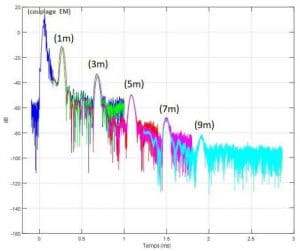
Figure 5 : stacking of time arrival envelopes of the L(0,1) mode, detected with the emitter-receiver magnetostrictive device in a low-frequency regime
No sample of double armor cable could be made available during the project. The results obtained on this structure are thus numerical. The modeling approach developed for a simple armor is not applicable to a double armor (dynamic cable). This is because the two layers of the armor rotate in opposite directions, which completely breaks the continuous symmetry of the problem. The approach we have developed is based on the theory of periodic media in two directions. For a double armor, the unit cell of the problem is thus reduced to a three-dimensional cell whose dimensions are of the order of the diameter of the wires (see Figure 6 on the left). However, theoretical difficulties arise due to the curvature of the two axes of periodicity (double helix geometry). As part of the project, we have proposed a particular coordinate system, of bi-helical type, proved the existence of wave modes in such a geometry, and then established the numerical implementation of our approach. The numerical results obtained on a double armor (see Figure 6 on the right) exhibit trends similar to those observed for a simple armor.
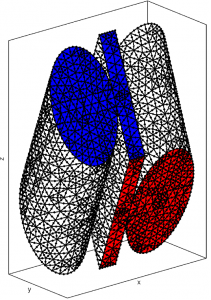
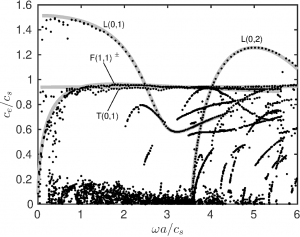
Figure 6 : numerical results for a double armor. Left : reduction of the FE mesh to the unitary repetitive cell of the problem, right : normalized energy velocity of wave modes as a function of frequency (gray lines : free wire results)
The results of the project allow to imagine an advantageous instrumentation for the monitoring of dynamic cables. This instrumentation consists in designing magnetostrictive transceiver collars, placed near critical areas of damage (connectors, hubs, etc.) – see Figure 7. The advantages of a magnetostrictive device are numerous. No special access is necessary since it can be mounted on the outer sheath directly. Its relatively low frequency operating regime allows the L(0.1) mode to propagate over ten meters. This propagation distance appears compatible with the extent of the critical areas. This type of device is global. It does not require any wire-to-wire instrumentation and is therefore less expensive and easier to implement. The know-how acquired during the project, in terms of modeling and experimentation methods, is likely to be exploited for other cable architectures and other types of devices as needed.
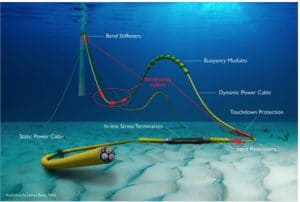
Figure 7 : cable of floating wind turbine. Red: localized instrumentation around critical areas using external magnetostrictive collars.
Publications and papers published
Publications
- Numerical modeling of waveguides accounting for translational invariance and rotational symmetry, Treyssède F., X International Conference on Structural Dynamics, In Procedia Engineering 199, p. 1562-1567, EURODYN 2017, Rome, 10-13 septembre 2017
- Free and forced response of three-dimensional waveguides with rotationally symmetric cross-sections, Treyssède F. , Wave Motion, 87, p. 75-91, Avril 2019
- Two-dimensional elastic Bloch waves in helical periodic structures, Zhou C, F. Treyssède, International Journal of Solids and Structures, Volumes 204–205, 2020
- Elastic guided waves in helical multi-wire armors, F. Treyssède, L. Laguerre, P. Cartraud, T. Soulard, Ultrasonics Volume 110, February 2021
Oral communications
- Ondes mécaniques dans les câbles pour leur évaluation non destructive : approche numérique et expérimentale, Treyssède F., Journée scientifique Évaluation non destructive dans le génie civil de l’énergie, Ifsttar, site de Nantes, 30 novembre 2017
- Modélisation numérique de la propagation des ondes guidées dans des câbles multibrins, Zhou C., F. Treyssède et P. Cartraud, JJCAB 2017 (Journées Jeunes Chercheurs en Vibrations, Acoustique et Bruit), Paris, 2017
- Modélisation numérique des guides d’onde tridimensionnels à section symétrique par rotation, Treyssède , F., 14ème Congrès Français d’Acoustique, Le Havre, 2018
- Modélisation numérique de la propagation des ondes guidées dans des milieux périodiques multi-hélicoïdaux, Zhou , C., F. Treyssède et P. Cartraud, 14ème Congrès Français d’Acoustique, Le Havre, 2018
- Propagation des ondes mécaniques dans des milieux périodiques multi-hélicoïdaux, Zhou C., F. Treyssède et P. Cartraud, Journées du GDR Ondes, Advanced theoretical and numerical methods for waves in structured media, Paris, 13-14 mars 2018
- Imagerie par gradient de défauts abrupts dans les barres enfouies, Gallezot M., F. Treyssède et L. Laguerre, Journée thématique GdR MecaWave, Méthodes inverses et imagerie : de la théorie aux applications, Paris, 2018.
- Imagerie rapide de guides d’ondes cylindriques d’accès restreint basée sur un formalisme modal, Gallezot M., F. Treyssède et L. Laguerre, 1er colloque du GDR MecaWave, Fréjus, 2018.
- Numerical modeling of elastic guided wave propagation in bi-helical periodic media, Zhou, C., F. Treyssède et P. Cartraud, 2nd Franco-Chinese Acoustic Conference (FCAC), Le Mans, 2018
- Propagation des ondes mécaniques dans les câbles ombilicaux destinés aux EMR en vue de leur évaluation non destructive, F. Treyssède, P. Cartraud, L. Laguerre, C. Zhou, Conférence GIS ECND – Nantes, 2019
Prospects
Development of reliable and low cost on-site techniques for the non destructive evaluation and the structural health monitoring of cables.




